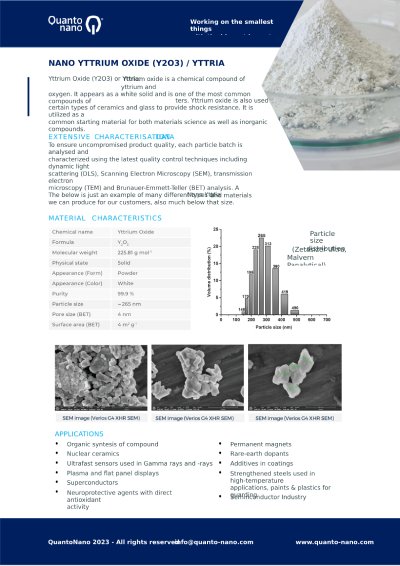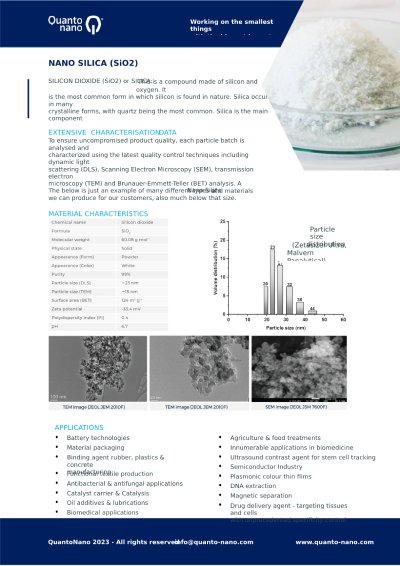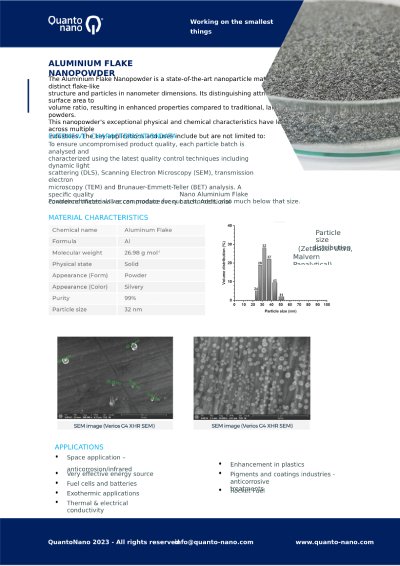Quanto Nano
Catalysts
Quanto Nano
Product Categories
Innovating Catalysis with Nanotechnology
Fundamentals of Nano Enhanced Catalysts
Quanto Nano
Key Characteristics:
This selectivity ensures that desired reactions occur preferentially, minimizing unwanted by-products and enhancing overall process efficiency. In the pharmaceutical industry, for instance, selective catalysis ensures the production of a specific drug compound without creating harmful or wasteful by-products, making the process more efficient both in terms of yield and environmental impact. Send Inquiry
Quanto Nano
Diverse Nanomaterials in Catalysis
- Gold (Au): Effective for oxidation reactions and in fuel cells.
- Silver (Ag): Used in oxidation and reduction reactions.
- Palladium (Pd): Crucial in hydrogenation and C-C coupling reactions.
- Platinum (Pt): Widely used in fuel cells and automotive catalytic converters.
- Ruthenium (Ru): Effective in Fischer-Tropsch synthesis, hydrogenation reactions.
- Rhodium (Rh): Used in hydroformylation and nitrogen oxide reduction.
- Cobalt (Co): Plays a role in Fischer-Tropsch synthesis and hydroformylation.
- Nickel (Ni): Crucial for hydrogenation and methane reforming.
- Titanium Dioxide (TiO2): Used in photocatalysis and environmental applications.
- Zinc Oxide (ZnO): Effective in photocatalytic degradation of pollutants.
- Iron Oxide (Fe2O3, Fe3O4): Utilized in magnetically separable catalysts.
- Aluminum Oxide (Al2O3): Offers support and increases the stability of other catalysts.
- Copper Oxide (CuO, Cu2O): Used in oxidation reactions and photocatalysis.
- Manganese Oxide (MnO, MnO2): Effective in oxidation reactions and in decomposing organic compounds.
- Ceria-Zirconia (CeZrO4): Offers thermal stability and oxygen storage capacity.
- Perovskites (e.g., LaMnO3): Known for their versatility in various oxidative reactions.
- Cobalt-Zinc Oxide (CoZnO): Utilized in alcohol synthesis and oxidation reactions.
- Nickel-Cobalt Oxide (NiCo2O4): Shows promise in electrocatalytic and photocatalytic applications.
- Bismuth Vanadate (BiVO4): Known for its photocatalytic activity, especially in water splitting.
- Quantum Dots: Used in photocatalytic applications due to unique electronic properties.
- Cadmium Selenide (CdSe): Used in photocatalytic applications, especially in hydrogen production.
- Lead Sulfide (PbS): Exhibits strong quantum dot properties, used in solar energy conversion.
- Titanium Nitride (TiN): Known for its photocatalytic and antibacterial properties.
- Carbon Nanotubes (CNTs): Enhance catalyst support and electron transfer.
- Graphene: Offers high surface area and conductivity.
- Fullerenes: Exhibits unique properties for catalysis, especially in photochemical reactions.
- Carbon Quantum Dots: Show potential in photocatalysis due to their tunable optical properties.
- Activated Carbon: Used for adsorption and support in various catalytic reactions.
- Graphene-Metal Oxide Composites: Enhance electron transfer and stability in photocatalysis.
- Pt-Au, Pd-Cu: Provide synergistic effects for improved catalytic activity.
- Au-Ag (Gold-Silver): Exhibits enhanced catalytic activity in oxidation reactions.
- Fe-Pt (Iron-Platinum): Used in magnetic catalysis and environmental applications.
- Ni-Pd (Nickel-Palladium): Shows synergy in hydrogenation and reduction reactions.
- Metal-Organic Frameworks (MOFs): Offer high surface area and tunable porosity for catalysis.
- Polymer-Based Nanocomposites: Combine polymers with nanoparticles for enhanced stability and specificity.
Quanto Nano
Current Research and Development Focus
Sustainability
Developing eco-friendly and energy-efficient catalytic processes.
Scalability
Ensuring that nanocatalysts can be produced at an industrial scale without losing efficiency.
Durability and Stability
Enhancing the lifetime and robustness of nanocatalysts under varying conditions.
Quanto Nano
Applications of Nano Enhanced Catalysts
Chemical Industry
Used in the synthesis of various chemicals, nano enhanced catalysts improve yield and reduce unwanted by-products. Improved selectivity and yield in pharmaceutical and chemical manufacturing.
Environmental Applications
Catalytic converters in vehicles use nanoparticles to reduce harmful emissions. Photocatalytic degradation of pollutants, water purification.
Energy Sector
In fuel cells, nano catalysts enhance the efficiency of energy conversion processes.
Quantum Size Effects
Exploiting quantum mechanical properties for novel catalytic behaviors.
Adjustable Electronic Properties
Tuning electronic configurations for specific reactions.
Pharmaceuticals
Synthesis of drugs becomes more efficient and environmentally friendly with nano catalysts.
Petrochemical Industry
Nano catalysts are crucial in refining processes, improving efficiency and reducing environmental impact.
Quanto Nano
Synthesis and Design
Controlled Synthesis
Design Flexibility
Plasma Deposition
Application in Nanocatalyst Synthesis
Plasma deposition is particularly useful for creating thin films of metal oxides or carbides, which are important in catalytic applications. The technique allows for the deposition of uniform, high-purity layers, essential for efficient catalytic reactions.
Advantages
This method offers precise control over film thickness and composition, and can be conducted at lower temperatures compared to conventional CVD, making it suitable for a wider range of substrates.
Laser Beam Deposition
Application in Nanocatalyst Synthesis
This technique is well-suited for producing metallic nanoparticles and complex structures like nanowires or nanotubes. It offers precise control over the size and shape of the nanoparticles, which is crucial for tailoring their catalytic properties.
Advantages
The main advantage of laser beam deposition is its high resolution and precision. It can produce extremely fine features and patterns, essential for designing catalysts with specific reactivity and selectivity.
Quanto Nano
Integration with Traditional Methods
Chemical Vapor Deposition (CVD)
Continues to be a mainstay for synthesizing a variety of nanomaterials, including metals, semiconductors, and insulators. Its compatibility with plasma and laser-based methods enhances its utility.
Sol-Gel Process
This method is excellent for producing oxide materials and allows for doping or incorporating various elements into the nanomaterial. It's often used in tandem with other techniques for post-processing and refining the properties of the nanoparticles.
Quanto Nano
Design Flexibility and Controlled Synthesis
Size, Shape, and Composition Control
Advanced deposition techniques, combined with traditional methods, provide an unparalleled ability to engineer nanoparticles with specific sizes, shapes, and compositions. This is crucial for optimizing their catalytic activity and selectivity.
Surface Modification and Functionalization
Techniques like plasma and laser beam deposition can be used to modify the surface properties of nanoparticles, enhancing their interaction with reactants and increasing their efficiency in catalysis.
Scalability and Reproducibility
One of the challenges in nanoparticle synthesis is maintaining consistency and scalability. These advanced methods are continuously being refined to ensure that nanoparticles can be produced reliably on a larger scale for industrial applications.
Quanto Nano
Research and Innovation Focus at Quanto Nano
Sustainable Solutions
Focusing on eco-friendly processes.
Customized Catalyst Development
Tailoring innovative catalysts for industry-specific challenges.
Collaborations
Partnering with leading institutions to advance nanocatalysis.
Quanto Nano
Advanced Properties, Optimizations and Behaviors
Quanto Nano
CONCLUSION AND FUTURE OUTLOOK
Bimetallic Nanoparticles
Combining two different metals at the nanoscale often results in synergistic effects, where the catalytic properties of the composite are superior to those of the individual metals.
Heterogeneous Catalysts
Designing nanoparticles with multiple active sites for different reactions can lead to catalysts capable of facilitating multiple reaction steps in sequence.
Quanto Nano
Responsive Behavior
pH-Responsive Materials
Certain nanomaterials can change their catalytic behavior based on the pH of the environment, offering smart control over reaction pathways.
Thermo-Responsive Catalysts
Some nanoparticles can alter their catalytic activity in response to temperature changes, useful in processes requiring temperature control.
Conclusion












